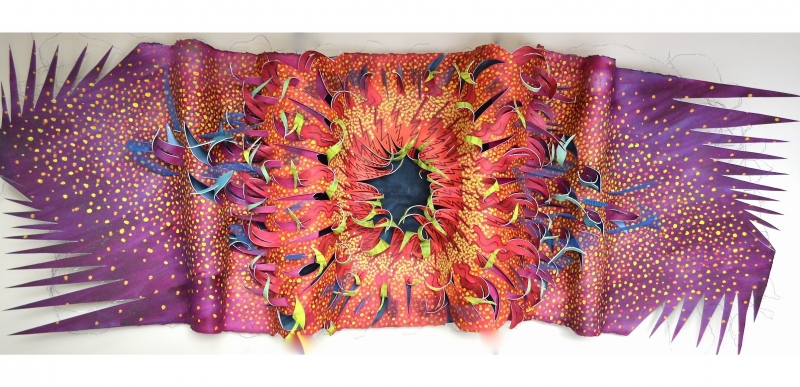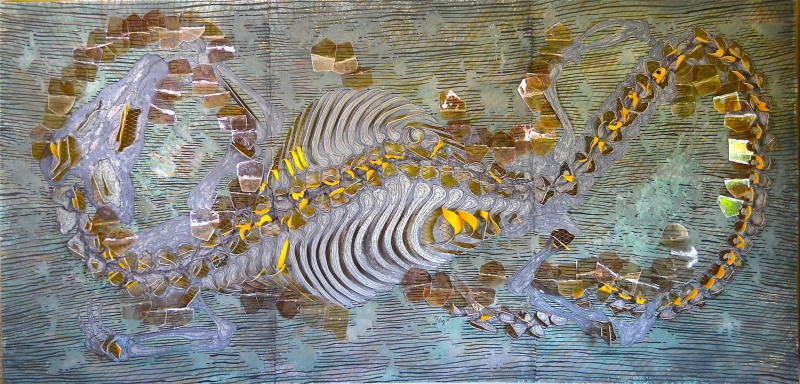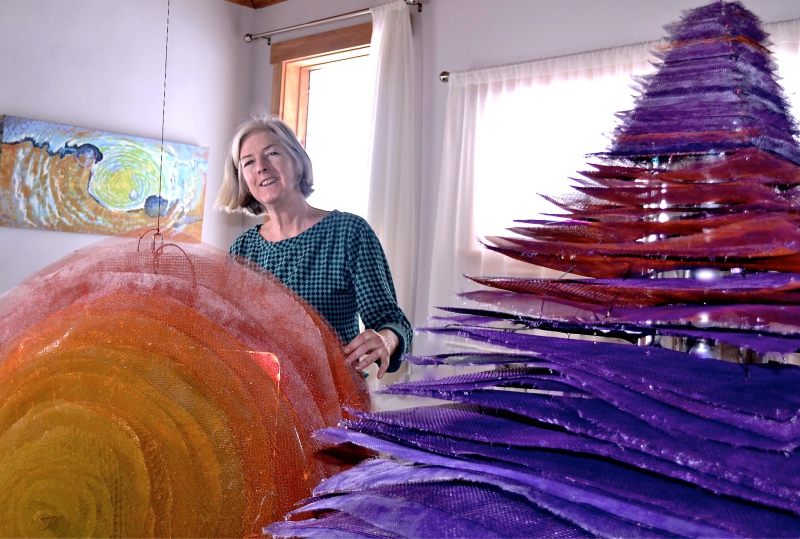By Meg Brazill
Carolyn Enz Hack grew up on her family’s farm in New Jersey and first found inspiration in the natural world. Since 2001, she and her husband, Garrett Hack, have lived on a farm in Thetford Center (along with a Belgian horse, cows, chickens, and a cat.) Carolyn is a painter and sculptor, a thinker and a maker. Garrett is a furniture maker, teacher, designer, and writer. They each have a studio on their farm and talk every morning about what’s going on in their creative lives.

Artist Carolyn Enz Hack with her work, “Sowing Good Will,” 2012. Wire, Hi-tec kozo paper, mixed media. Approx. 55 in. x 124 in. x 15 in.
“Garrett will often ask me about design issues he’s working on, and I may ask him about an engineering issue that I’m trying to solve,” Enz Hack says. Farms, she notes, are great places for inspiration and reflection, and Enz Hack continues to draw from that source as a genesis for much of her work.
Enz Hack describes her vision as “optimistic with a sense of connectedness to the world.” In the past five years she has been exploring new artistic directions and investing new meaning into her work.
It’s paying off. Enz Hack was the 2016 recipient of a Jury Award from the Arts Alive Festival of Fine Art Exhibition and has twice received a Vermont Arts Endowment Award from the Vermont Community Foundation, as well as a Vermont Arts Council grant.
Reflecting change
When Enz Hack has a new idea, it usually means months of working, sketching, questioning, and building before it takes shape as a work of art.
“What interests me is taking ideas and giving them a physical form,” she explains. “I’m interested in poking and prodding ideas, giving shape to thought.” Her work is not intentionally ambiguous, but she doesn’t provide answers either. That she leaves up to the viewer.
Recently she’s been exploring the idea of change in the greater sense.
“It’s about changing your mind in terms of not staying static, always being in motion to evolve your thought processes, to become a better person,” she says. “You have a way of being set in your mind, but it’s not set in stone. You can always change it.”
The end result will be “Change Your Mind,” a solo exhibition in the Mary Sommer Room at Brattleboro Museum of Art (BMAC), Jan. 14 to March 5. In conjunction with the exhibit, Enz Hack will give an artist talk there on Thursday, Feb. 23, at 7p.
A dramatic background
Since 2011, Enz Hack has had eight solo exhibitions and exhibited in more than 25 group shows. Her fine art career is relatively recent: For decades she worked in scenic design at professional theaters including the Intiman Theatre and the Empty Space Theatre in Seattle. She earned her bachelor of fine arts in Theatrical Design from Mason Gross School of the Arts at Rutgers University. After moving to Vermont in 1993, she designed for the Northeast Shakespeare Ensemble while raising her two young daughters, Jett and India, now 27 and 25, respectively.
In 1999 she met Garrett Hack. When they married in 2001, their combined family made for a household of two adults and five children. The other three children, now grown, are Zoe, 33, Matisse, 25, and Kipling, 21, who is a junior at Cornell.
“We had a lot going on in this house,” Enz Hack tells us. “Garrett (mostly) and I built everything that’s on this land, including his Federal style brick woodworking studio.”
New decade, breaking through
Enz Hack had been painting since 2000 with some success but wanted to ramp things up. She looked forward to a month-long artist residency at the Vermont Studio Center in 2011, but when she got there, she drew a complete blank. So she gave herself some parameters: start with a piece of paper. Take nothing from it. Add nothing to it.
“It was sort of a mathematical problem,” she explains. What began as a plane became a complex 3-D sculpture, what Enz Hack calls sculptural paintings.
She began using that technique to explore a question: How many acts of good does it take to counteract one act of evil? That began the series, “Evil Divided by Good.” And then Enz Hack began to divide her time between the new sculptures and her paintings.
It was also, she says, a shift toward trying to bring more meaning into her art:
“I’m interested in dynamic art that catches people and draws them in to another place, to evolve their thought process. It’s something other than shock or anger.”
When “Sowing Good Will” was to be hung in the Great Hall in Springfield, Enz Hack hoped it would grab people’s attention. Would it cause them to pause and ask, What is it and what is it doing here?
“If it would hold their attention for more than 10 seconds, I’ve achieved my goal,” the artists says with a warm smile.
Separate, together
While Carolyn Enz Hack’s art is underway, her husband is equally busy. Garrett Hack is a well known and widely respected teacher and furniture maker. As Enz Hack puts it, “I’m one of those women who’s married to a guy who is famous in certain circles.” For the two of them, it has meant many things, including collaborating on some furniture projects that have been exhibited at the Currier Museum of Art and the Society of Arts and Crafts in Boston.
“We often collaborate during the design stage of his work and I’ve contributed paint to a long list of his finished pieces. He sometimes helps me solve build problems,” Enz Hack explains.
Like any working couple, combining busy work schedules, travel and other of life’s demands, they have a lot to juggle. “It has become more of a balance between us over the years, both at home and on the road,” she adds.
Hack’s teaching has taken the couple to many parts of the world, including Japan and Australia. An annual teaching gig in Germany takes them abroad for months at a time. Enz Hack travels with her husband, using the time to sketch and paint and to gather inspiration.
“In my travels, I always go into churches, railroad stations, mosques—places where people gather. The ancient places, in particular, are beautiful,” Enz Hack says.
‘Change Your Mind’
For the past year, “Change Your Mind” has been taking shape in Enz Hack’s 12-foot by 18-foot studio in a wing of their house. As she works on the physical manifestation of the idea, she has questions to answer: How do I bring a completely nonrepresentational concept to fruition? What will it be made of?
When she determines what the physical object will look like, new problems arise around materials, engineering, and building.
“The solutions change the outcome. To physically build that piece, it has to evolve [beyond the drawing],” Enz Hack says. “The ideas in my head seem so simple, but when I get started, solving the problems can be very difficult. The thing that gives a piece soul is that process of making.”
“Change Your Mind,” is a pyramid and a sphere, constructed of wire mesh panels, varying in size. The pyramid begins with a 40-inch-square mesh footprint; the sphere’s 40-inch circumference is made of wire mesh circles.
And here’s where her theatrical training comes in.
“I made a model of the room and of the sculpture in it, and decided that this was the right size. The room is the container for it; the room is part of the piece,” she says. The work includes a poem written by her sister, Susan M. Enz.
The pyramid and the sphere have a connecting bridge between them, which can indicate transition or balancing.
“For me, it’s a representation that you can think one thing, but it may not be true. It can be the opposite thing,” Enz Hack says. “It’s the idea that your perspective in life may be a fallacy. It doesn’t have to be true for you to believe.”
In that spirit, the title, “Change Your Mind,” can be seen as a directive or a question. Perhaps Enz Hack is challenging the viewer to do just that. In making the work, she has changed her mind many times. Visit the exhibit and find out whether you might change yours.
Enjoy Carolyn Enz Hack’s work via her website [www.carolynenzhack.com] and in “Change Your Mind” in the Mary Sommer Room at Brattleboro Museum of Art, Jan. 14-March 5.

























































